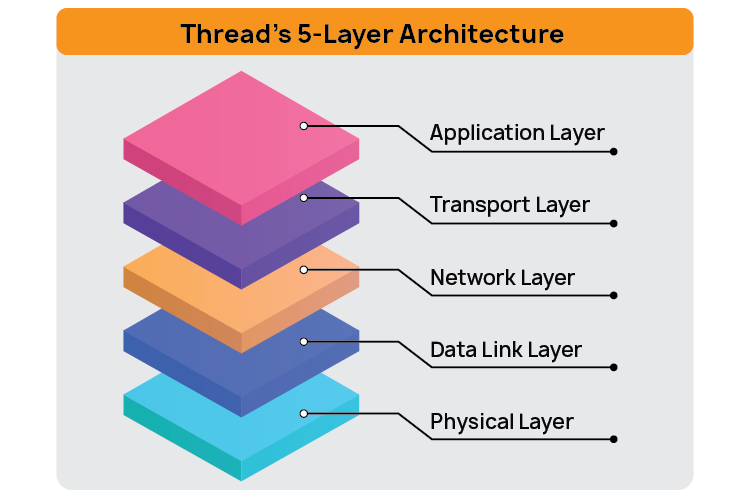

ACL Digital
5 Minutes read
IoT Connectivity with Thread Protocol
In today’s hyper-connected world, seamless communication among devices is critical to creating smart, efficient, and intuitive environments. Imagine a world where all your devices – from thermostats to lighting systems – connect effortlessly through a powerful “Thread.” Not the kind you sew with, but a revolutionary wireless protocol purpose-built for IoT.
Thread is transforming how devices interact by delivering secure, reliable, and energy-efficient connectivity, whether in homes, businesses, or entire cities. As the Internet of Things continues to reshape industries with its promise of convenience and innovation, choosing the right communication protocol becomes crucial to managing large networks effectively. Thread stands out as an ideal solution, creating self-healing mesh networks that enable devices to communicate even beyond direct range, ensuring consistent performance without disruptions. Built on IPv6, it offers unmatched scalability, low power consumption, and interoperability across diverse smart home and industrial products.
In this blog, we will explore how Thread is redefining IoT connectivity, addressing challenges of scalability, security, and integration, and paving the way for a smarter, seamlessly connected future.
Key Features of Thread
Low Power Consumption
Thread is optimized for battery-powered IoT devices such as sensors, thermostats, and smart locks. It supports sleep modes and efficient communication protocols that significantly reduce power usage, extending device battery life and reducing the need for frequent recharging.
Secure Communication (AES-128 Encryption)
Thread ensures data security with built-in AES-128 encryption and device authentication. Only authorized devices can join the network, safeguarding sensitive information and maintaining the integrity of both home and commercial IoT systems.
Self-Healing Mesh Network
Devices within a Thread network form a resilient, self-healing mesh. If one device fails or becomes unreachable, the network automatically reroutes communication through alternate paths—ensuring continuous operation without manual intervention.
Scalability and Flexibility
Built on IPv6, Thread supports virtually unlimited device addresses, making it ideal for networks of any size—from small smart homes to large-scale building automation systems. Its architecture allows for easy expansion as your IoT ecosystem grows.
Direct, Hub-Free Communication
Thread eliminates the need for a central hub. Devices communicate directly with each other, simplifying setup and reducing single points of failure. This decentralized approach enhances reliability and network responsiveness.
Seamless Device Integration
Using MeshCoP and standard onboarding methods like QR codes, NFC, or BLE, adding devices to the network is fast, secure, and intuitive. Thread offers a plug-and-play experience, enabling even non-technical users to expand their smart systems effortlessly.
Dynamic Routing & Multi-Channel Support
Each device maintains an intelligent routing table to ensure optimal message delivery. Thread also supports multi-channel communication, reducing congestion and interference. This ensures smooth, uninterrupted connectivity even in dense or complex environments.
Understanding the Difference: Thread, Wi-Fi, and Zigbee for IoT Connectivity
| Feature | Thread | Wi-Fi | Zigbee |
| Power Consumption | Low-power; ideal for always-on devices | High; suited for data-heavy applications | Low, but less efficient in large meshes |
| Network Type | Mesh (self-healing, scalable) | Point-to-point or star | Mesh (limited scalability) |
| IP Support | Native IPv6 support | IP-based | No native IP; needs a gateway |
| Ecosystem Integration | Works with Google Home, Apple HomeKit | General support | Limited integration |
| Ideal Use Case | Smart homes, sensors, automation | Streaming, browsing, high-bandwidth | Home automation with a Zigbee hub |
Thread’s 5-Layer Architecture
Thread Protocol follows a 5-layer architecture designed to support reliable, secure, and efficient communication in IoT environments. Following are the simplified overview:
Application Layer
Utilizes user-level protocols like CoAP and MQTT to enable smooth interaction between smart devices such as thermostats and wearables.
Transport Layer
Ensures reliable, error-free data delivery using protocols like UDP and TCP, maintaining robust communication even when packet loss occurs.
Network Layer
Uses IPv6 and RPL for efficient routing within the mesh network, allowing data to take the best path and enabling self-healing in case of device failure.
Data Link Layer
Provides dependable communication and error detection using IEEE 802.15.4, tailored for low-power wireless connectivity.
Physical Layer
Sends data over radio frequencies in the 2.4 GHz or sub-1 GHz bands, supporting long-range and energy-efficient communication among IoT devices.

Problem Statement
The client, a leading US-based lighting and controls manufacturer, needed a technology partner to enhance their existing ZigBee and Thread-based lighting products and develop a gateway solution that enables quick connectivity and remote control of lighting devices via mobile apps and laptops.
Challenges
- Lack of enhanced capabilities for existing ZigBee and Thread-based lighting products
- Absence of a seamless integration mechanism for controlling devices remotely
Solution
- Designed a customized IoT gateway using ACL Digital’s Modular IoT Gateway platform
- Integrated multi-protocol connectivity including Thread, Zigbee, Wi-Fi, Ethernet, and radio expansion
- Enabled remote OTA updates for end devices and ensured battery backup for uninterrupted operations
- Developed a connected web application featuring floor plan creation and device placement per floor
- Enabled commissioning, control, and monitoring of 200+ devices with local control and cloud APIs
- Delivered an intuitive UI with distinct user and admin access for streamlined management
- Implemented a robust rules engine with alarms and notifications for proactive responses
- Conducted comprehensive functional and performance testing to ensure solution reliability
Conclusion
ACL Digital empowers clients to build scalable, reliable, and energy-efficient IoT solutions by leveraging the Thread protocol’s advanced capabilities. From designing customized multi-protocol IoT gateways and developing intuitive control applications to implementing secure, mesh networks, ACL Digital ensures seamless device integration, extended battery life, and robust connectivity. This holistic approach enables clients to accelerate their smart home and building automation initiatives with future-ready, cost-effective, and high-performance IoT solutions.
Related Insights



How Generative AI is Transforming Project Risk Management

Death to Prompting! Long Live Programming!

The Architecture of Agentic RAG: Reasoning-Driven AI Systems Explained

